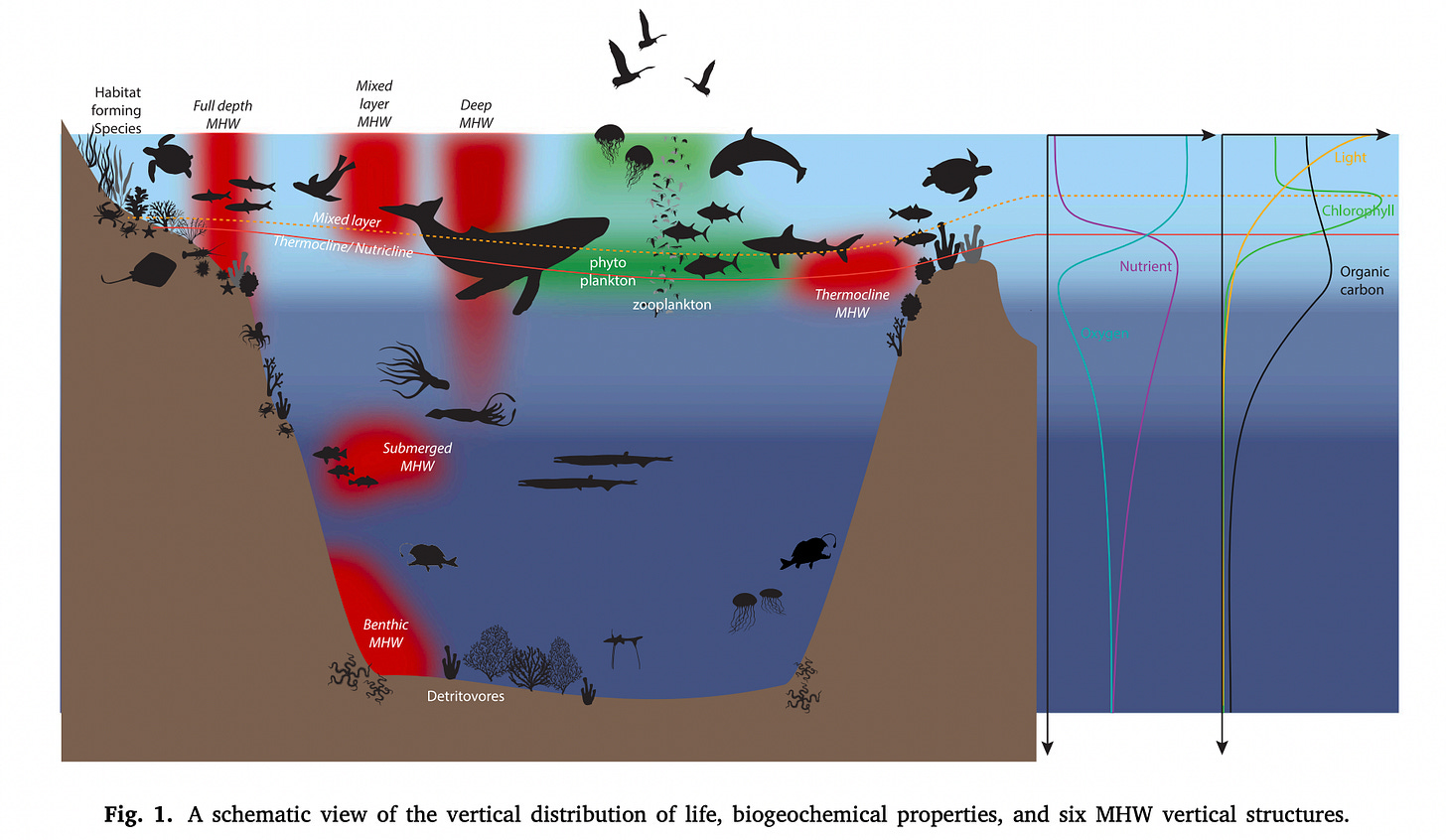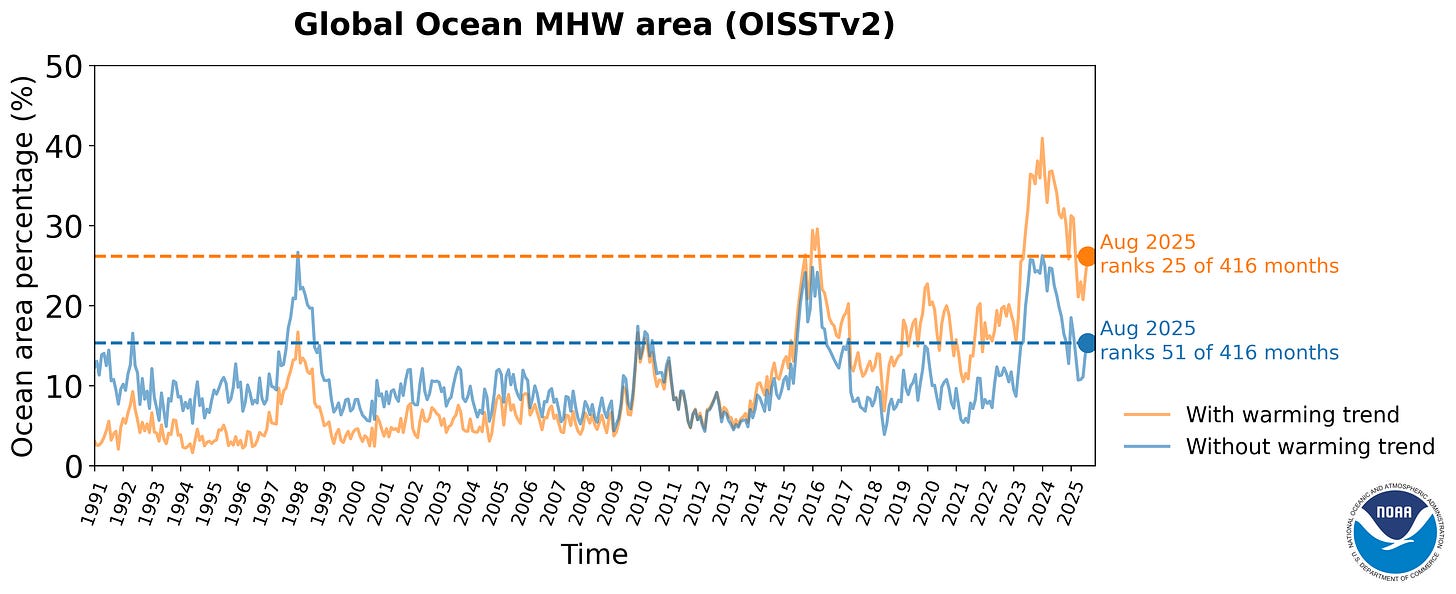What are marine heatwaves?
Summer is coming to a close and the water temperature is at its most variable here in San Diego. When ocean temperatures spike above normal levels for days or weeks, we call it a marine heatwave. Most people think of these events as surface phenomena, tracked by satellites and felt by bare skin with a hint of topper. But marine heatwaves are more complex than what we see at the surface, with different types occurring at various depths throughout the water column, each with distinct causes and consequences.
Recent research out of Australia has identified six main types of marine heatwaves based on where extreme temperatures occur in the water column. Mixed layer marine heatwaves affect the well-mixed surface layer where surfers and swimmers spend their time. These typically extend down a few tens of meters and result from atmospheric heating, reduced wind mixing, or warm surface currents. Deep marine heatwaves start at the surface but penetrate much deeper, extending well below the mixed layer into the thermocline where temperature drops rapidly with depth. The notorious heatwave named “Blob” sizzled in the North Pacific from 2013-2016 exemplified this type, with warm anomalies reaching hundreds of meters deep and significantly affecting kelp density on the US West Coast.

Three types of marine heatwaves can occur beneath the surface with little or no visible signature at the top. Thermocline marine heatwaves concentrate around the depth where temperature gradients are steepest, often between 50-200 meters deep in most coastal areas. These result from vertical movements of water masses that push warm water deeper or pull it up from below. Submerged marine heatwaves occur even deeper, well below the thermocline in the relatively stable waters of the deep ocean where temperature variations are normally minimal. Benthic marine heatwaves affect the seafloor, particularly important on continental shelves where bottom-dwelling organisms have nowhere to escape the elevated temperatures.
Full depth marine heatwaves represent the most comprehensive events, with extreme temperatures extending from surface to seafloor. These typically occur in coastal regions where the entire water column experiences warming, often driven by the shoreward movement of warm ocean currents or eddies. When the East Australian Current pushes onto the continental shelf, for example, it can create full depth heatwaves that affect everything from surface plankton to bottom-dwelling sea urchins.

The mechanisms driving these different heatwave types vary considerably. Surface heating from reduced cloud cover, weakened winds, or atmospheric high pressure systems typically generate mixed layer events. Ocean dynamics drive deeper heatwave types. Vertical movements of water masses from many sources, known as “heave,” can push the thermocline up or down, creating temperature extremes at depth with little or no surface signature. Large-scale ocean currents, meandering fronts, and spinning eddies can transport warm water horizontally, creating heatwaves when they arrive in new locations. Coastal wind patterns also play a role, with downwelling conditions pushing warm surface water deeper along the coast.
Each type of marine heatwave creates different ecological impacts depending on which organisms live at the affected depths. Mixed layer heatwaves primarily stress surface-dwelling phytoplankton and the zooplankton that feed on them, potentially cascading up the food web to fish, seabirds, and marine mammals. Deep heatwaves affect the midwater realm where many commercially important fish spend their time, potentially forcing them to relocate to cooler waters. Benthic heatwaves can be devastating for sessile organisms like corals, kelp, and sponges that cannot move to escape the heat. These have caused massive die-offs of foundation species from California kelp forests to Australian coral reefs. Full depth events combine all these impacts, affecting entire coastal ecosystems simultaneously.
Researching these different heatwave types matters because roughly 20-40% of marine heatwaves occur entirely below the surface, invisible to satellites. This hidden warming can persist for months after surface conditions return to normal, creating prolonged stress for deep-water ecosystems. As ocean monitoring improves and we develop better ways to forecast these events, recognizing the full three-dimensional nature of marine heatwaves becomes crucial for predicting their ecological and economic impacts.
Further Reading:

